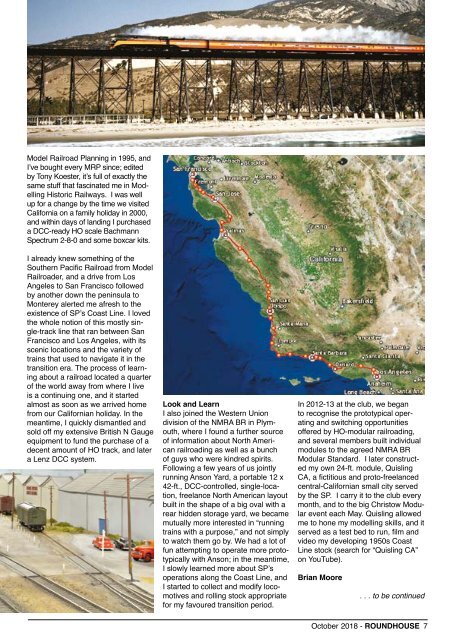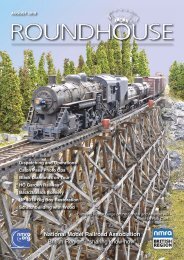NMRA RH October 2018
You also want an ePaper? Increase the reach of your titles
YUMPU automatically turns print PDFs into web optimized ePapers that Google loves.
Model Railroad Planning in 1995, and<br />
I’ve bought every MRP since; edited<br />
by Tony Koester, it’s full of exactly the<br />
same stuff that fascinated me in Modelling<br />
Historic Railways. I was well<br />
up for a change by the time we visited<br />
California on a family holiday in 2000,<br />
and within days of landing I purchased<br />
a DCC-ready HO scale Bachmann<br />
Spectrum 2-8-0 and some boxcar kits.<br />
I already knew something of the<br />
Southern Pacific Railroad from Model<br />
Railroader, and a drive from Los<br />
Angeles to San Francisco followed<br />
by another down the peninsula to<br />
Monterey alerted me afresh to the<br />
existence of SP’s Coast Line. I loved<br />
the whole notion of this mostly single-track<br />
line that ran between San<br />
Francisco and Los Angeles, with its<br />
scenic locations and the variety of<br />
trains that used to navigate it in the<br />
transition era. The process of learning<br />
about a railroad located a quarter<br />
of the world away from where I live<br />
is a continuing one, and it started<br />
almost as soon as we arrived home<br />
from our Californian holiday. In the<br />
meantime, I quickly dismantled and<br />
sold off my extensive British N Gauge<br />
equipment to fund the purchase of a<br />
decent amount of HO track, and later<br />
a Lenz DCC system.<br />
Look and Learn<br />
I also joined the Western Union<br />
division of the <strong>NMRA</strong> BR in Plymouth,<br />
where I found a further source<br />
of information about North American<br />
railroading as well as a bunch<br />
of guys who were kindred spirits.<br />
Following a few years of us jointly<br />
running Anson Yard, a portable 12 x<br />
42-ft., DCC-controlled, single-location,<br />
freelance North American layout<br />
built in the shape of a big oval with a<br />
rear hidden storage yard, we became<br />
mutually more interested in “running<br />
trains with a purpose,” and not simply<br />
to watch them go by. We had a lot of<br />
fun attempting to operate more prototypically<br />
with Anson; in the meantime,<br />
I slowly learned more about SP’s<br />
operations along the Coast Line, and<br />
I started to collect and modify locomotives<br />
and rolling stock appropriate<br />
for my favoured transition period.<br />
In 2012-13 at the club, we began<br />
to recognise the prototypical operating<br />
and switching opportunities<br />
offered by HO-modular railroading,<br />
and several members built individual<br />
modules to the agreed <strong>NMRA</strong> BR<br />
Modular Standard. I later constructed<br />
my own 24-ft. module, Quisling<br />
CA, a fictitious and proto-freelanced<br />
central-Californian small city served<br />
by the SP. I carry it to the club every<br />
month, and to the big Christow Modular<br />
event each May. Quisling allowed<br />
me to hone my modelling skills, and it<br />
served as a test bed to run, film and<br />
video my developing 1950s Coast<br />
Line stock (search for “Quisling CA”<br />
on YouTube).<br />
Brian Moore<br />
. . . to be continued<br />
<strong>October</strong> <strong>2018</strong> - ROUNDHOUSE 7



